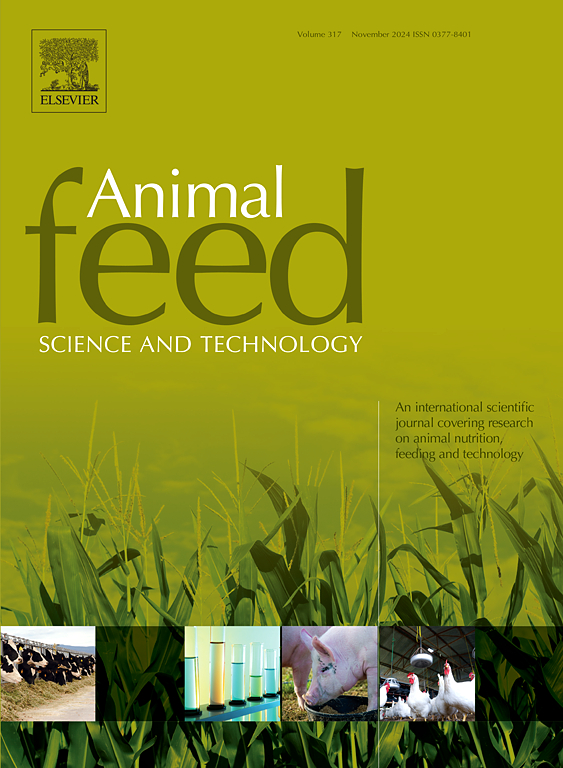饲粮不同蛋白质来源对大口黑鲈幼虫生长性能、消化能力和氨基酸谱的影响
IF 2.7
2区 农林科学
Q1 AGRICULTURE, DAIRY & ANIMAL SCIENCE
引用次数: 0
摘要
大口黑鲈(Micropterus salmoides)幼虫的成功饲养在很大程度上依赖于有效微饲料的开发,以提高驯化的成功和生长。本试验旨在评价不同蛋白质来源(鱼粉、磷虾粉和鱿鱼粉)在大口黑鲈幼鱼断奶期的饲喂效果,并以Artemia (AR)和商品饲料(CD)为对照。结果表明,SM日粮的生长结果(末重[FBW]和特定生长率[SGR])仅次于AR日粮,其主要原因是SM日粮具有较高的饲料效率和蛋白质效率。鱼粉组、KM组和CD组的增重和增重无显著差异。此外,与其他微饲料组相比,豆粕组消化系统更发达,胰蛋白酶活性更高,但脂肪酶和淀粉酶活性在鱼粉、豆粕和豆粕组之间差异不显著。氨基酸组成结果表明,SM和AR组的赖氨酸、精氨酸和谷氨酸水平显著高于其他各组,而KM组的甘氨酸水平最高。生长相关基因(胰岛素样生长因子1 (igf-1)和生长激素(gh))在SM组肝脏和大脑中的表达水平明显高于其他微饮食组。综上所述,SM是能显著提高大口黑鲈幼虫驯化成功率的主要蛋白质来源。本文章由计算机程序翻译,如有差异,请以英文原文为准。
Effects of different dietary protein sources on the growth performance, digestive capacity and amino acid profiles of largemouth bass (Micropterus salmoides) larvae
The successful rearing of largemouth bass (Micropterus salmoides) larvae heavily relies on the development of effective microdiets that enhance domestication success and growth. Herein, a 28-day feeding experiment was conducted to evaluate the effectiveness of different protein sources, namely, fish meal (FM), krill meal (KM) and squid meal (SM), during the weaning phase of largemouth bass larvae, with Artemia (AR) and commercial diet (CD) used as controls. Our results indicated that larvae fed with SM diet exhibited growth outcomes (final body weight [FBW] and specific growth rate [SGR]) second only to those of larvae fed with AR, which was attributed to its higher feed and protein efficiency ratios. No significant difference was observed in the FBW and SGR among the FM, KM and CD groups. In addition, the SM group had a more developed digestive system and higher trypsin activity than the other microdiet groups, although the lipase and amylase activities were not significantly different among the FM, KM and SM groups. The results of amino acid composition indicated that the levels of lysine, arginine and glutamate in the SM and AR groups were significantly higher than those in the other groups, whereas the level of glycine was the highest in the KM group. The expression levels of growth-related genes (insulin-like growth factor 1 (igf-1) and growth hormone (gh)) were markedly higher in the liver and brain of the SM group than in those of the other microdiet groups. In conclusion, our results suggest that SM is the main protein source that can considerably improve the domestication success rate of largemouth bass larvae.
求助全文
通过发布文献求助,成功后即可免费获取论文全文。
去求助
来源期刊

Animal Feed Science and Technology
农林科学-奶制品与动物科学
CiteScore
6.00
自引率
6.20%
发文量
266
审稿时长
3 months
期刊介绍:
Animal Feed Science and Technology is a unique journal publishing scientific papers of international interest focusing on animal feeds and their feeding.
Papers describing research on feed for ruminants and non-ruminants, including poultry, horses, companion animals and aquatic animals, are welcome.
The journal covers the following areas:
Nutritive value of feeds (e.g., assessment, improvement)
Methods of conserving and processing feeds that affect their nutritional value
Agronomic and climatic factors influencing the nutritive value of feeds
Utilization of feeds and the improvement of such
Metabolic, production, reproduction and health responses, as well as potential environmental impacts, of diet inputs and feed technologies (e.g., feeds, feed additives, feed components, mycotoxins)
Mathematical models relating directly to animal-feed interactions
Analytical and experimental methods for feed evaluation
Environmental impacts of feed technologies in animal production.
 求助内容:
求助内容: 应助结果提醒方式:
应助结果提醒方式:


